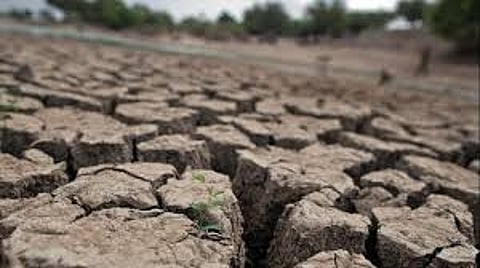

#Ajayan
Kochi | Back-to-back drought conditions in Kerala have attracted good attention as part of realized changes in the climate. The last severe drought in the State, worst and even extreme, was in 2016. Already, there is an over 35 per cent deficiency during the present monsoon which does not augur well for the State.
This extreme drought condition may be attributed to the combined effect of realized changes in the mean climate State as well as the climate variability, says a study ‘Changing Characteristics of Droughts over Kerala, India: Inter-Annual Variability and Trend’ by Cochin University for Science and Technology scientists Abhilash S, EK Krishnakumar, P Vijaykumar, AK Sahai, B Chakrapani and Girish Gopinath.
It says southwest monsoon has been decreasing over south Kerala during recent decades, when post-monsoon rainfall has been found to be increasing, especially over south Kerala. There exists a weak relationship between Pacific Sea surface temperature (SST) and Kerala rainfall.
Long term variations in precipitation and temperature are considered as common indicators of climate change over a region. Based on the altitude, Kerala terrain is mainly divided into three categories - low land, midland and highland. The unique annual and seasonal distribution of rainfall across Kerala and along the Western Ghats region is mainly accountable for the exceptional repository of a variety of flora and fauna.
The 2016 drought imposed a severe threat to both agriculture and hydrology. The frequency of drought years is increasing over Kerala during recent decades, the study says. Each deficit rainfall year is unique in the sense that its impact on agriculture, hydrology and socio-economic sectors may vary. Though southwest monsoon during 2015 was bad for Kerala, the annual water stress and severity of drought during 2015 did not scale up to the level of 2016.
Interestingly, all India summer monsoon rainfall was deficit during 2015 and Kerala also received deficit rainfall during summer monsoon. It also received deficit summer monsoon during 2016 when it was normal across the country. This points to the large heterogeneity in rainfall distribution and its inter-annual variability. Agriculture in Kerala is mostly rainfed and less than 30 per cent is dependent on irrigation.
Kerala’s annual rainfall averages around 300 cm with 15 per cent inherent variability. The southwest monsoon season con[1]tributes 65–70 per cent of the annual rainfall followed by the post-monsoon season (northeast monsoon) with a share of 15–20 per cent and a small contribution during the pre-monsoon season.
Hence rainfall deficit during southwest and northeast monsoons largely determines the severity of the annual drought. Any shortfall in the monsoon rainfall will be compensated during post-monsoon to some extent and thus bringing the annual rainfall within normal.
The annual and summer monsoon rainfall over Kerala is showing a decreasing trend and northeast monsoon is found to be increasing. Reduction in monsoon rainfall over Kerala is mainly driven by both the weakening of upper and lower-level monsoonal circulations. Any shortfall in one season is compensated by the other so that annual water stress is minimized during most of the years.
In general, annual drought years are associated with extreme JJAS (weak summer monsoon) and also correspond to El Nino (unusual warming of surface waters in the eastern tropical Pacific Ocean) years. However, extreme northeast monsoon drought years need not necessarily lead to annual drought and such northeast monsoon extreme droughts are more pronounced during La Nina (cooling of the water in the equatorial Pacific) events.
There exists a weak negative (positive) relationship between Pacific Sea surface temperature and Kerala summer monsoon during El Nino and La Nina years. This relationship reversed in the case of post monsoon rainfall. It is found that following an extremely deficit JJAS season of 2016, the northeast rainfall became more than 60 per cent deficit. Occurrence of longer time-scale droughts are becoming more frequent in the recent decades over Kerala.
The study says an alarming decreasing trend of southwest monsoon rainfall over Wayand district has attracted attention of local administration and the Government has started devising better adaptation and mitigation measures.
